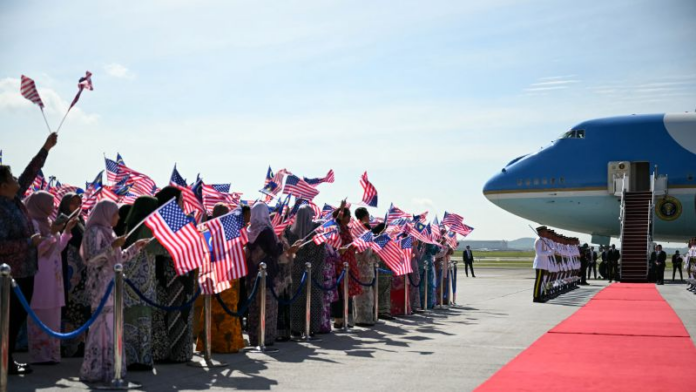We’re tracking President Donald Trump’s diplomatic tour in Asia, as he firms up a string of agreements in the region.
Trump has left Malaysia and is now on his way to Japan, where he will meet the country’s first female prime minister, Sanae Takaichi, on Tuesday.
In the Malaysian capital Kuala Lumpur, Trump joined the signing of a peace declaration between Thailand and Cambodia. Trump has repeatedly called it a peace “treaty,” though the document called it a joint declaration and Thai diplomats were more measured in their description.
Video Ad Feedback
Thailand and Cambodia sign peace agreement
01:16 • Source: CNN
Thailand and Cambodia sign peace agreement
01:16
Cambodia and Malaysia each signed reciprocal trade agreements with the US that include access to critical minerals.
Trump also met with Brazil’s President Luiz Inácio Lula da Silva while in Kuala Lumpur, signaling an ease in relations following a major rift this year. Lula said he was “convinced” his country would soon strike a trade deal with the US, with both sides saying they had a very good meeting.
Across town, US trade negotiators reached the framework of a trade deal with China. US Treasury Secretary Scott Bessent indicated that an escalation in tariffs on China is “effectively off the table” following what he described as “very good” trade talks. Chinese negotiators echoed that characterization, saying the sides had reached a “basic consensus.”
Bessent also said soybean farmers are going to be “extremely happy” with the terms of the deal, and that he, too, had been burdened by trade tensions with China as the owner of soybean and corn farms.
The progress set the table for Trump’s high-stakes meeting with Chinese leader Xi Jinping this week.
Video Ad Feedback
Video: What’s next for Trump-Xi trade talks
01:11 • Source: CNN
Video: What’s next for Trump-Xi trade talks
01:11
Stocks rose in response to news of the progress.
Beyond trade talk, Trump is expected to urge Xi to join the US pressure campaign against Russia. “China needs to join the US and our other allies in raising their voice and saying that this senseless (Ukraine) war needs to end,” US Ambassador to NATO Matthew Whitaker said Sunday. Last week, the Trump administration unexpectedly announced “massive sanctions” on Russia’s two biggest oil producers.
US President Donald Trump is en route to Japan to meet Emperor Naruhito and sit down with the country’s new prime minister, Sanae Takaichi, for the first time on Tuesday.
Though the US-Japan alliance is one of the world’s strongest, Takaichi’s limited diplomatic experience and Trump’s unpredictability make their first meeting a critical test.
Their talks are expected to cover tariffs, regional security and Japan’s defense spending, all points of tension in recent months. Within Japan’s conservative ruling party, some worry Washington’s commitment to the Indo-Pacific is fading, as it demands more from allies.
Defense will top the agenda: Under former Prime Minister Fumio Kishida, Japan pledged to raise defense spending to 2% of GDP by 2027. Takaichi now wants to accelerate that timeline to March 2026, calling for Japan to “proactively advance the fundamental strengthening of its defense capabilities.” But how the buildup will be financed remains unclear. With the yen weakening and Takaichi pushing tax cuts, she may struggle to fund her ambitions.
Trade could prove equally thorny: Since returning to office, Trump has reignited his tariff wars, targeting even longtime allies. After months of talks, tariffs on Japanese goods dropped from 25% to 15%, while Tokyo agreed to invest $550 billion in US industries. But many details remain vague, and Takaichi is expected to seek more clarity.
Read more about the key issues that shape US-Japan ties.
As negotiators from Washington and Beijing work toward securing a deal between the top global economies, we’re taking a step back and looking at some key components of the potential trade pact.
• Fentanyl: Li Chenggang, China’s top trade negotiator, indicated that the countries had reached a consensus on efforts to combat the production of the drug, which has become a leading cause of death for American minors. The US could lift or reduce a 20% tariff that the Trump administration imposed on China in April to halt the export of fentanyl’s precursor chemicals.
• Soybeans: US Treasury Secretary Scott Bessent said China will make “substantial” purchases of US soybeans. Soybean farmers in states like Illinois, Iowa, Minnesota and Indiana have been harvesting this fall without purchase orders from China, once the largest buyer of American soybeans ($12.5 billion).
• Rare earths: The framework could also delay export curbs on rare-earth minerals, which threaten to reduce US access to the materials used in military equipment, smartphones, televisions and batteries used in electric vehicles.
• TikTok: Trump and Xi are also expected to finalize a deal to transfer ownership of TikTok, the popular short-form video app that was first slated to be banned but received multiple extensions. The White House has announced that a US investor group led by Oracle’s Larry Ellison would operate the app’s algorithm, allowing it to continue US operations for its more than 170 million users.
Negotiators from the US and China have signaled progress on trade talks between the global powers, with US Treasury Secretary Scott Bessent touting the “substantial framework” of a deal to avoid escalating tariffs.
But US officials have indicated the future of a potential trade deal will ultimately hinge on this week’s meeting between US President Donald Trump and Chinese leader Xi Jinping.
Here’s a look at where the relationship stands:
• Trump and Xi met face-to-face five times during the US president’s first term, including a Mar-a-Lago welcome for Xi and a Trump trip to Beijing.
• At their most recent in-person meeting, in June 2019 on the sidelines of a G20 summit, the US and China were seeking a trade deal amid major tariff escalations by both countries. Though Trump and Xi described that June meeting positively, both countries continued to lash out with further tariff threats and had on-and-off negotiations.
• Trump has long heralded Xi’s leadership and touted a warm relationship with his counterpart, whom he’s described both as a “friend” and “extremely hard to make a deal with.”
• Beijing is seeking some predictability from Trump, who notoriously conducts a capricious brand of diplomacy.
• Trump threatened to call off this week’s meeting earlier this month, as a period of relative calm was shattered by new trade tensions over rare earths, tech exports and tariffs. But the US president voiced optimism before leaving on his trip, indicating last Wednesday that he’s heading into talks in dealmaking mode.



